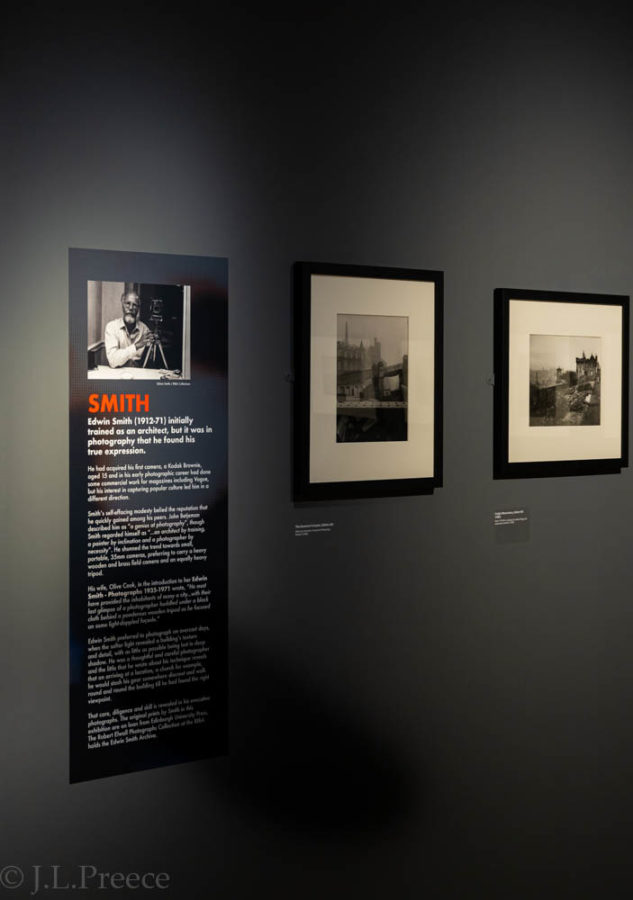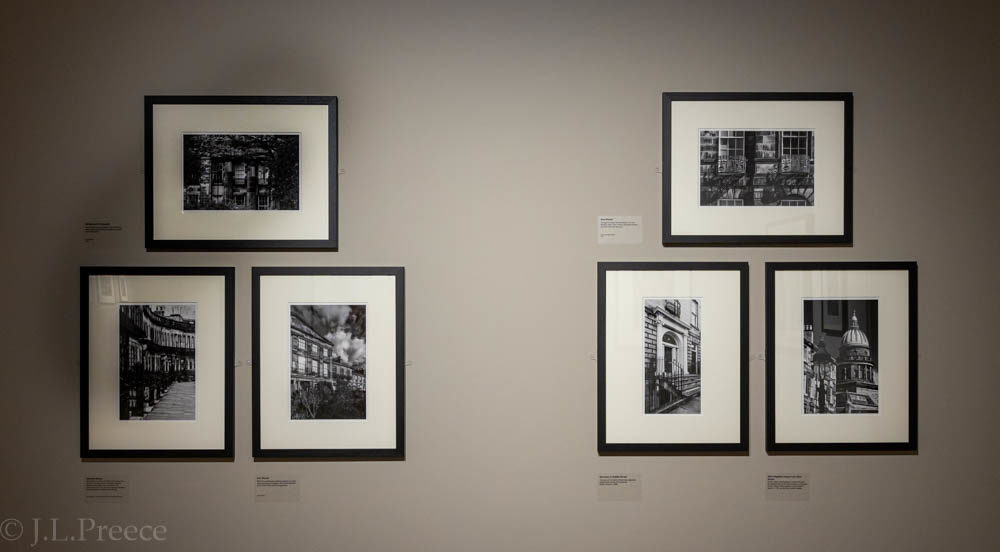At the City Art Centre – Classical Edinburgh
Today a one bedroom flat in Edinburgh’s New Town might easily cost you half a million pounds. It’s hard to imagine, as you walk through those leafy squares and quiet crescents, that there was a time when things were quite different.
Classical Edinburgh, a new exhibition at the City Art Centre, tells the story of the New Town’s rise, fall and renaissance, contrasting a photographic record from the 1960s with new images of the same sites taken over 50 years later.

Designed by James Craig in 1776, the New Town was planned as a ‘suburb’ for the more affluent residents of the Old Town, who were fed up with the overcrowding and insanitary conditions in the tenements across the Nor Loch.
As the Age of Enlightenment dawned, the last thing the City Fathers wanted was an exodus of wealth; the rich had somehow to be persuaded not to decamp to London. The Neo-Classical architecture, spacious townhouses, private gardens and quiet lanes of the New Town did the trick, and George Street, Charlotte Square, Heriot Row, Frederick Street and their like soon became some of the most desirable addresses in the city.
By the 1960s, the charm had faded.
Many parts of the New Town had fallen into disrepair – some buildings were in such a state that demolition was threatened. The Modernist architect Sir Robert Matthew led efforts to save the area, and a survey organised by the Edinburgh Architectural Association assessed the scale of the repairs needed to reverse the effects of years of neglect. Then in 1966 an Edinburgh University academic published what remains the standard work on the development of the New Town.

Professor Alexander J Youngson was already an eminent economic historian. His interest in his urban surroundings inspired him to write The Making of Classical Edinburgh, and this, together with an exhibition ‘200 Summers in the City’, finally helped to galvanise people into action. Speaking at the Scottish Civic Trust’s 1970 conference on The Preservation of Georgian Edinburgh, Youngson explained that the cost of saving the New Town would be about £15 million;
‘This does not seem to me to be too high a price to pay for the retention of a little piece of civilisation.’
The argument was won. The Edinburgh New Town Conservation Committee was set up by the city council and the government, and one of the world’s most ambitious conservation programmes began. In 1999 the Committee became, along with the Edinburgh Old Town Renewal Trust, Edinburgh World Heritage.

Youngson’s book, which had played such a huge part in saving the New Town, was illustrated by photographs taken by one Edwin Smith. Smith, an eminent but modest English photographer, understood the fragility of the environment and valued above all the preservation of regional diversity.
He had worked in London, Ireland, Italy and France – still using the traditional method of camera, tripod, and blanket over the head – and had already visited Edinburgh in 1954, although most of the images in the book were taken ten years later.
The photographs shown at the City Art Centre, all of them black and white, were originally thought lost, but eventually turned up in a box at Edinburgh University Press. Now architectural photographer Colin McLean (who was once a student of Youngson’s at Edinburgh University, and is Chair of the Scottish Civic Trust) has reshot some of Smith’s locations. The results offer interesting comparisons.
-

Edwin Smith’s image from the roof of Jenners looking West -

Colin McLean’s interpretation of Smith’s image from Salisbury Crags -

Edwin Smith’s image over The Dumbiedykes from Salisbury Crags
Craig’s Observatory, Calton Hill (1964) and Edinburgh, looking West from the (Salisbury) Crags to the Castle (1954) have blurred, smoky horizons while McLean’s colour photograph of the latter shows a crisp, clear panorama extending to the Forth Bridge and the Five Sisters Bing, the latter 19 miles away in West Lothian.
McLean may had have the benefit of modern technology, but the reason for the difference is much simpler – in Smith’s time the skies were indeed full of smoke. Auld Reekie didn’t get that name for nothing, and prior to the Clean Air Acts and the advent of smokeless fuel, smog was as much a problem here as in London.
Smith’s evocative North Bridge, looking South from the Wellington Statue (1964) at first appears very similar to McLean’s; in both the Duke of Wellington dominates the foreground, his right hand raised in command to his troops, his favourite horse Copenhagen rearing up on his hind legs. It’s the small details that give the game away. In Smith’s image the traffic is lighter, the buses a long-gone version of the current fleet, the traffic lights similarly old fashioned. Beneath the statue a flat-capped man reads a newspaper.
-

North Bridge from Register House -

Colin McLean with two ‘versions’ of an image looking up North Bridge
The Mound, with New College in the middle distance (Smith) contrasts the classicism of William Playfair’s Royal Scottish Academy with the Tudor frontage of New College towering above it. The buildings may not have changed, but the young woman carrying her portfolio across the street instantly dates this photograph; the high heels, swing coat and short, chic hair are pure Mary Quant.
One image shows a part of Edinburgh that has been transformed not once but twice since Smith’s time. In St James’, central doorway, East side, Smith captured the last days of tenements erected in the late 18th century. Two women, one holding a baby, stand at the door. A car in the road has a ‘GB’ sticker, suggesting that the residents (if it belongs to them) are able to enjoy foreign travel. In 1965 the tenements were demolished to make way for the first St James Centre. Now, in 2019, the city awaits its second incarnation.

Both Smith and McLean have photographed the interior of the Royal High School. In Smith’s image we see the classical Greek doorway through which leavers would pass on their journey from the classrooms to the wide world. In the 1970s the door was removed when the building was converted for an aborted Scottish Assembly; hence it is missing from McLean’s contemporary shot.
The magnificent pillars and filigree ironwork balconies found in many New Town streets are shown in both photographers’ work. Smith’s Moray Place 1964 and McLean’s Chester Street celebrate these facades. In McLean’s Alva Street the shadows of the wrought iron bars are reflected on the walls below. His image of Ainslie Place is clearly of its time, featuring as it does one of the council’s patent anti-seagull rubbish bags hanging from the railings.
McLean’s photograph of the interior of The Dome is a kaleidoscope of colour, the bar a riot of oranges and yellows, the enormous pillars on either side of the entrance a burnished red. Everything coveys opulence in this former home of the Commercial Bank, but now it is cocktails, not cheques, that are dispensed across its counters.
Although the New Town is dominated by neo-Classical architecture, McLean has found some interesting contrasts. In Thistle Court on Thistle Street, a matching pair of 18th century houses have a more homely feel, their front gardens full of trees and shrubs. An image of the statue of Queen Victoria (dressed as Britannia) on top of the Royal Scottish Academy is backed by the pointed neo-Gothic windows of Playfair’s New College.
A competition, supported by Jessops, was held in conjunction with the exhibition, inviting people to submit their own images of Classical Edinburgh. There were four categories, After Dark, Seasons, Working Life and Architectural Gems, and the winning and runner-up entries are also displayed at the Centre.
The Scottish National Gallery at Night by Don Munro (winner, After Dark) is a wonderfully evocative image of two people walking along the path. Wet leaves cover the ground, while the blurred lights of New College shine above. India Street Short Cut by Anne Conrad (runner-up, After Dark) is another excellent shot, with its shadowy steps and old brickwork, while Alistair Cowan’s view through the crown glass of Old College creates an unusual image of the buildings opposite.
There are a number of events associated with the Classical Edinburgh exhibition, including lectures, creative classes for adults, family events and photography tours. Many are free, but booking is required. For full details visit the City Art Centre’s website here or pick up a leaflet in the gallery.
Classical Edinburgh is at the City Art Centre, Market Street, Edinburgh, until 8 March 2020. Admission is free.


